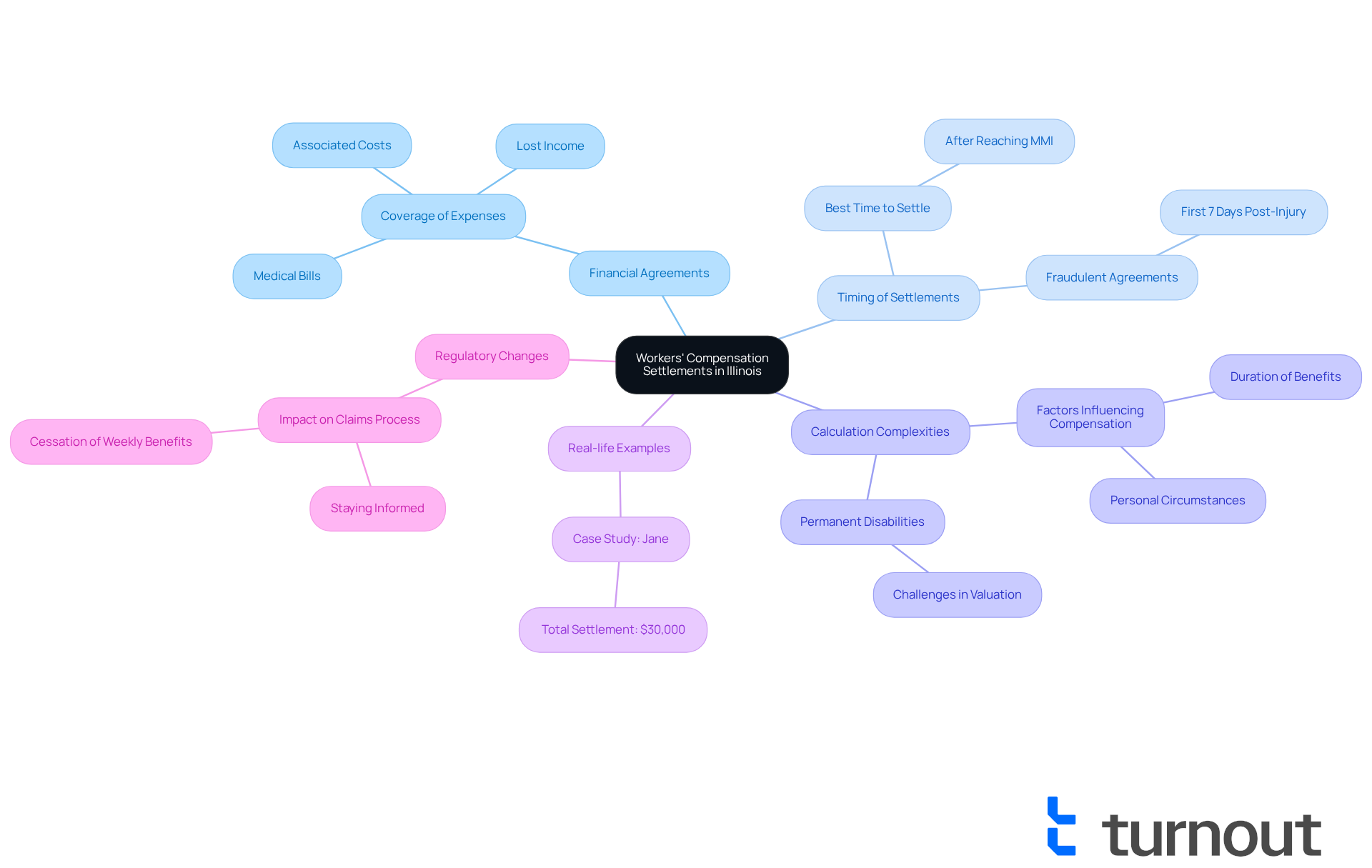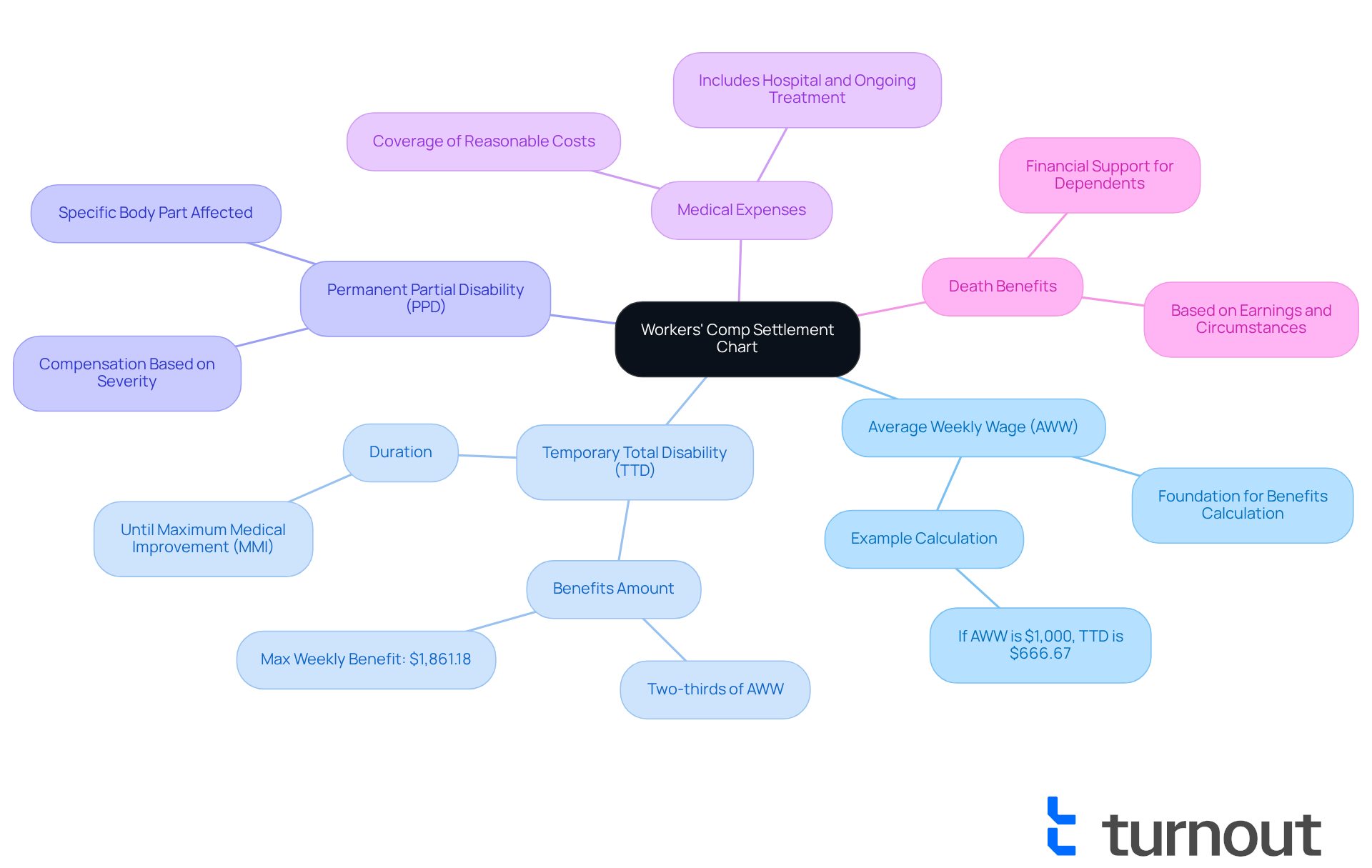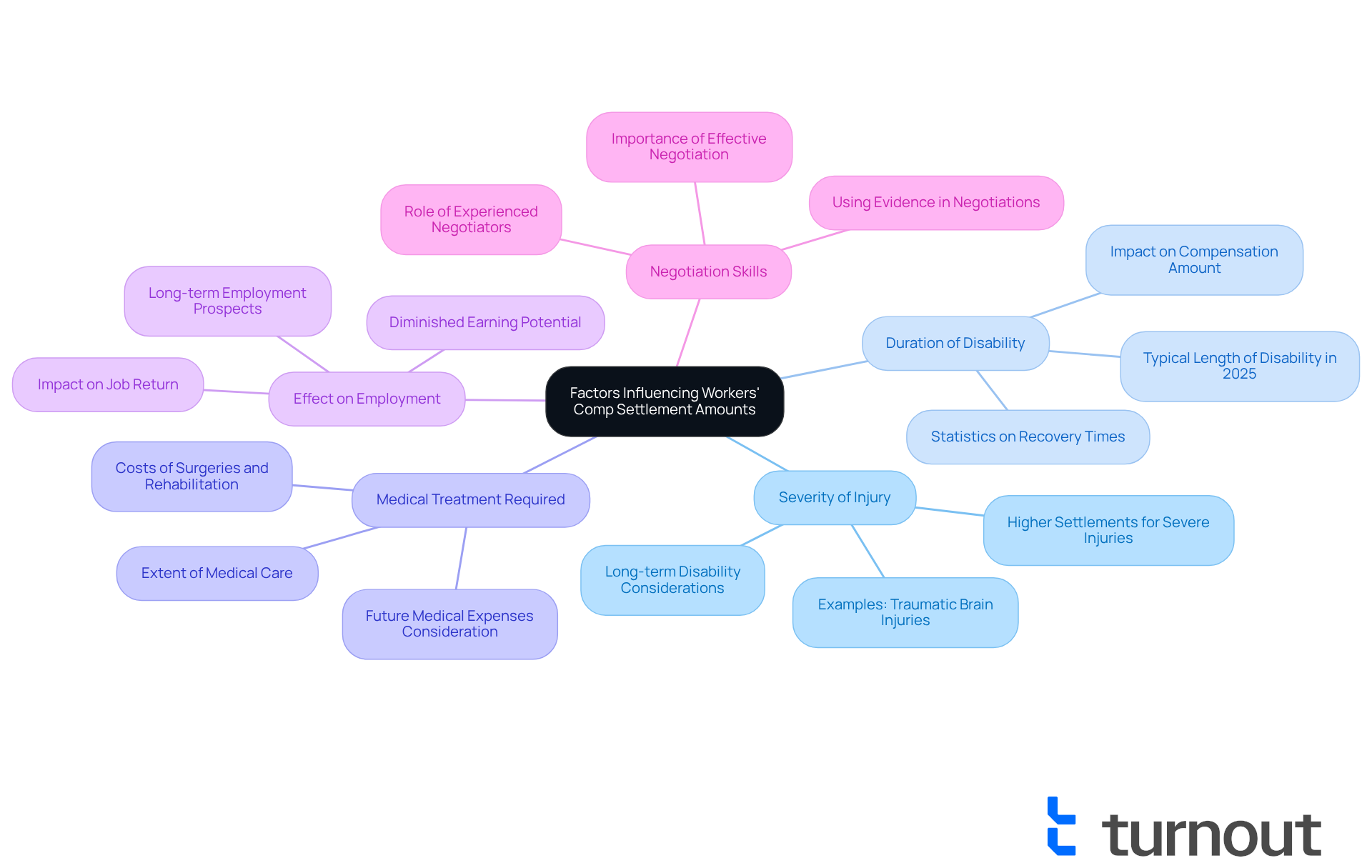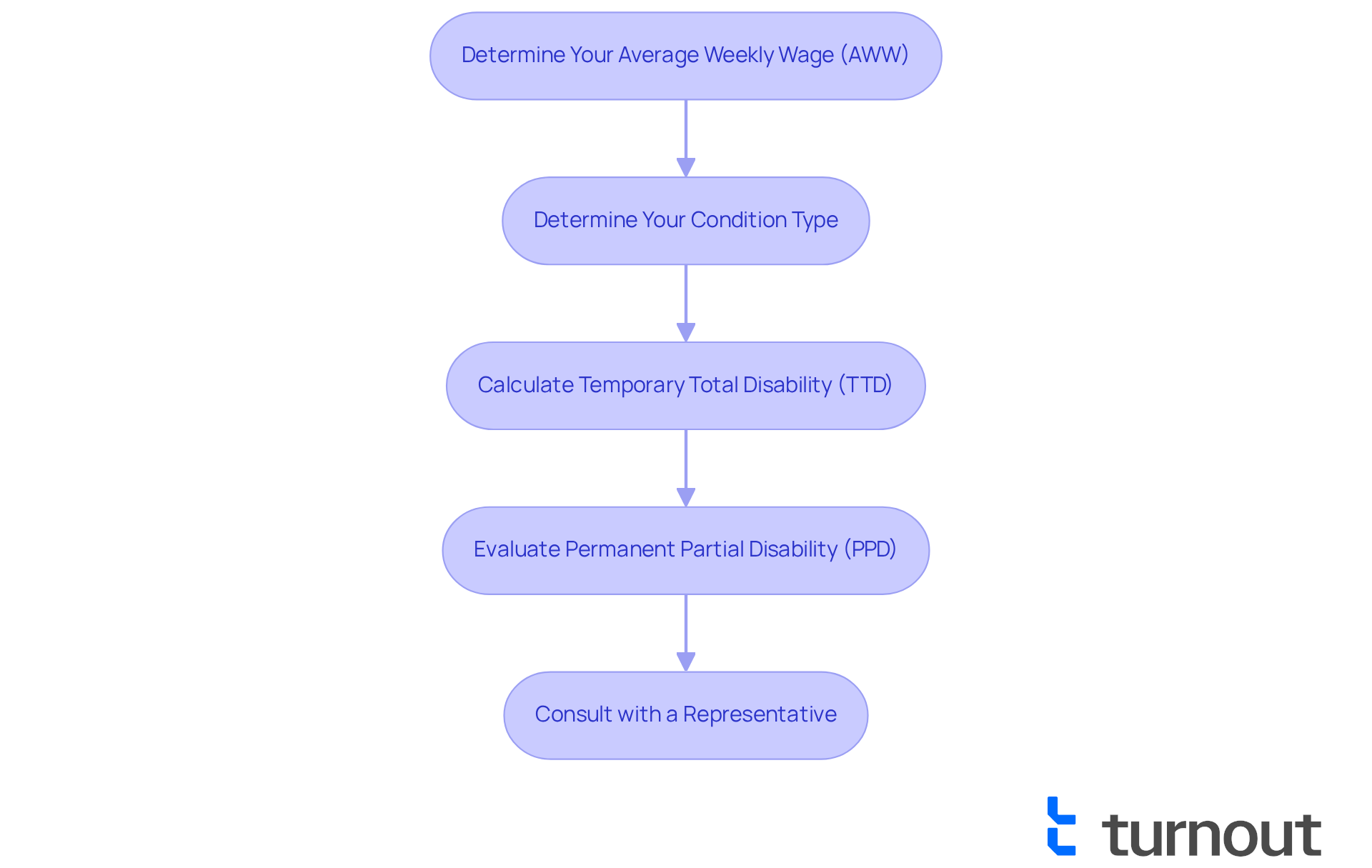Overview
This article aims to guide you in understanding and effectively utilizing the Workers' Compensation Settlement Chart in Illinois. We recognize that navigating this process can be challenging, and having knowledge of key components—such as Average Weekly Wage, Temporary Total Disability, and the factors that influence settlement amounts—is essential. These elements significantly impact the financial support available to injured workers, and we want to ensure you feel equipped to achieve fair compensation. Remember, you are not alone in this journey, and we’re here to help you every step of the way.
Introduction
Understanding the intricacies of workers' compensation settlements in Illinois is essential for employees navigating the challenges of work-related injuries. We recognize that these settlements provide not only crucial financial support for medical expenses and lost income but also empower individuals to navigate a complex web of regulations and negotiations. It's common to feel overwhelmed by the process, especially when considering the various factors that influence settlement amounts. So, how can you ensure you receive fair compensation?
This article delves into the vital components of the Illinois workers' comp settlement chart. We offer insights and strategies designed to maximize your benefits while addressing the uncertainties that often accompany the claims process. Remember, you are not alone in this journey—we're here to help.
Overview of Workers' Compensation Settlements in Illinois
Workers' financial agreements in Illinois serve as a vital support system for employees facing injuries or health issues related to their work. These agreements are designed to cover a range of expenses, including medical bills, lost income, and other associated costs. Understanding the Illinois employee benefits system is essential, as it operates under specific regulations that dictate how aid is calculated and distributed. This knowledge empowers individuals to know what to expect and prepares them for effective negotiations with insurance providers.
We understand that navigating the intricacies of workers' compensation claims can be daunting. As Mr. Jason Going points out, reaching maximum medical improvement (MMI) is often the best time to settle, allowing for a more accurate evaluation of the true costs of an injury. It's important to note that agreements can be proposed at any stage of the claims process, except within the first seven days following an injury, which are classified as fraudulent agreements.
Real-life examples illustrate the complexities of calculating compensation, especially for those with permanent disabilities. Take, for instance, Jane, a construction employee whose total workers' compensation payout reached $30,000. This case highlights how personal circumstances can significantly impact the outcome. Factors such as the duration of potential benefits and related costs must be carefully evaluated to ensure a fair resolution. In 2025, the workers comp settlement chart Illinois shows that typical settlements for employees reveal these complexities, with amounts varying greatly based on individual situations and the nature of the harm.
Recent changes in Illinois compensation regulations have also reshaped the claims landscape, emphasizing the importance of staying informed about your rights and the evolving rules. It's crucial to recognize that resolving a workers' compensation case may result in the cessation of weekly benefits, which cannot be reopened for the same condition. Consulting with experienced professionals can greatly improve your chances of achieving a favorable outcome, as they can provide personalized guidance throughout the settlement process. Remember, you are not alone in this journey; we're here to help you navigate these challenges.

Key Components of the Workers' Comp Settlement Chart
Navigating the workers comp settlement chart Illinois can feel overwhelming, but understanding its essential components can make a significant difference in your journey.
-
Average Weekly Wage (AWW): This crucial figure serves as the foundation for calculating benefits. It reflects your earnings before the accident, ensuring that the payment aligns with your usual income, providing a sense of security.
-
Temporary Total Disability (TTD): If you find yourself temporarily unable to work due to an injury, TTD benefits are here to support you. In Illinois, these benefits typically amount to two-thirds of your AWW, with a maximum weekly benefit of $1,861.18. For instance, if your average weekly wage is $1,000, you could receive approximately $666.67 per week during your recovery. This financial assistance is vital as you focus on healing.
-
Permanent Partial Disability (PPD): For those who have experienced lasting impairments yet can still work, PPD compensation is available. This support is tailored based on the severity of your disability and the specific body part affected, ensuring that you receive the appropriate assistance you deserve.
-
Medical Expenses: We understand that medical bills can add stress during a challenging time. Thankfully, all reasonable and necessary medical costs related to your accident are covered, including hospital expenses and ongoing treatment. This allows you to concentrate on your recovery without the burden of medical debt.
-
Death Benefits: In the unfortunate event of a job-related fatality, dependents may receive financial support based on the individual’s earnings and the circumstances surrounding the death. This provision aims to provide some comfort to families during their most difficult moments.
Understanding these elements is crucial for navigating the complexities of employee claims in Illinois, particularly in relation to the workers comp settlement chart Illinois for TTD benefits. Expert insights emphasize the importance of accurately assessing the AWW to ensure fair compensation, as it directly impacts the benefits you receive. Remember, you are not alone in this journey; we are here to help you every step of the way.

Factors Influencing Workers' Comp Settlement Amounts
Several factors significantly influence the amount of a workers comp settlement chart Illinois, and we understand that navigating this process can be challenging.
-
Severity of Injury: More severe injuries typically lead to higher settlements due to increased medical costs and longer recovery times. For example, harm that necessitates surgery or leads to lasting disability often results in compensations that consider the long-term effects on a person's ability to work.
-
Duration of Disability: The length of time an employee is unable to perform their job can greatly influence the compensation amount, especially for Temporary Total Disability (TTD) benefits. It's common to feel concerned about how long recovery might take. In 2025, the typical length of disability for workers' compensation claims in Illinois is expected to be greater for serious conditions, as indicated by the workers comp settlement chart Illinois, highlighting the necessity for sufficient compensation. Recent statistics show that severe injuries can prolong the average duration of disability considerably, which in turn affects the overall compensation value outlined in the workers comp settlement chart Illinois.
-
Medical Treatment Required: The extent and cost of medical treatment needed for recovery are essential factors in calculating compensation. Injuries requiring continuous care or rehabilitation can significantly enhance the total compensation amount. For instance, medical costs associated with surgeries and prolonged therapies can incur substantial expenses that must be considered in the resolution.
-
Effect on Employment: If an accident hinders a worker's ability to return to their former position or limits future job prospects, this can result in a larger amount as indicated by the workers comp settlement chart Illinois. We recognize that harm affecting essential functions or leading to lasting disabilities usually results in compensations that consider diminished earning potential. As highlighted by industry experts, the seriousness of an injury is a crucial element in negotiation discussions, emphasizing the importance of detailed records and strategic support in obtaining fair remuneration.
-
Negotiation Skills: The ability to negotiate effectively with insurance providers plays a vital role in determining the final compensation amount. Experienced negotiators can use evidence of injury severity and its impact on daily life to achieve more favorable settlement results. Specialists in the area emphasize that successful negotiation can greatly influence the ultimate agreement, ensuring that injured workers receive the compensation they deserve.
Practical examples demonstrate these concepts: situations involving traumatic brain injuries or significant spinal damage often result in larger compensations due to the substantial effect on a person's quality of life and earning capacity. Including specific case studies or statistics related to the effects of injury severity on settlements can provide a clearer view of how these elements manifest in real cases. Remember, you are not alone in this journey; we are here to help you navigate these challenges.

How to Use the Workers' Comp Settlement Chart in Illinois
To effectively use the Workers' Comp Settlement Chart in Illinois, follow these steps:
-
Determine Your Average Weekly Wage (AWW): Start by calculating your AWW based on your earnings before the incident. This figure is foundational for all subsequent calculations. In Illinois, the average maximum weekly rate for Temporary Total Disability (TTD) benefits was $1,402.23 in 2016, which can give you a benchmark for your potential benefits.
-
Determine Your Condition Type: Refer to the chart to find the specific ailment or condition you are claiming. Each wound has a specified reimbursement range, such as 205 weeks for a permanent hand wound.
-
Calculate Temporary Total Disability (TTD): If applicable, calculate your TTD benefits by taking two-thirds of your AWW and multiplying it by the number of weeks you are expected to be unable to work. This calculation is crucial for understanding your immediate financial recovery.
-
Evaluate Permanent Partial Disability (PPD): If your condition leads to a permanent impairment, utilize the chart to ascertain the weeks of compensation based on the affected body part and the extent of the disability. For example, injuries to the hand may entitle you to 205 weeks of benefits.
-
Consult with a Representative: Consider collaborating with an informed representative who can assist in understanding the chart and navigate you through the claims process, ensuring you optimize your compensation potential. As noted by a representative from Rosenfeld Injury Lawyers, "Understanding the nuances of your claim can significantly impact your settlement outcome."
Case Studies on Calculating Average Weekly Wage
- Method #2: Adjusting for Lost Workdays: For individuals who lost more than 5 workdays in the past 52 weeks, this method requires subtracting those lost days from the total weeks worked before calculating the AWW. This adjustment ensures that the AWW reflects only the weeks in which the individual was actively earning wages, providing a more accurate financial recovery basis.
- Method #3: Calculation for Short-Term Employment: This method is applicable for employees who have worked for less than a year, where the total number of weeks worked is used instead of the standard 52 weeks. This method is especially beneficial for seasonal employees, ensuring that their AWW is determined by their actual work duration.
Guidelines for Using the Workers' Comp Settlement Chart
Understanding the payout workers' comp settlement chart is critical for setting realistic expectations. The chart outlines the maximum number of weekly payments for various permanent injuries, such as 205 weeks for a permanent hand injury. Maintaining thorough documentation of all healthcare-related expenditures is crucial for inclusion in the agreement, as these expenses can considerably affect the ultimate payment sum. For instance, accurately documenting medical expenses can ensure they are included in your settlement, potentially increasing your overall compensation.

Conclusion
Navigating the complexities of workers' compensation settlements in Illinois can be overwhelming for many employees. We understand that this system is intricate, and being informed about the various components of the workers' comp settlement chart is essential. By grasping these elements, you can better prepare for negotiations and ensure you receive the fair compensation you deserve for your injuries.
It's important to determine your Average Weekly Wage (AWW) and recognize the types of benefits available, such as:
- Temporary Total Disability (TTD)
- Permanent Partial Disability (PPD)
Understanding how the severity of your injury and the duration of your disability can impact your compensation is crucial. Additionally, consulting with experienced professionals can provide the guidance you need throughout the settlement process, ensuring that you are not alone in this journey.
Ultimately, knowledge is power when it comes to workers' compensation settlements in Illinois. By being proactive and informed, you can navigate the complexities of your claims more effectively. Stay updated on the latest regulations and utilize resources like the workers' comp settlement chart to maximize your potential benefits. Taking these steps not only aids in achieving a favorable outcome but also contributes to a more secure recovery process. Remember, we’re here to help you every step of the way.
Frequently Asked Questions
What is the purpose of workers' compensation settlements in Illinois?
Workers' compensation settlements in Illinois provide financial support for employees facing injuries or health issues related to their work, covering expenses such as medical bills, lost income, and other associated costs.
When is the best time to settle a workers' compensation claim?
The best time to settle a workers' compensation claim is often after reaching maximum medical improvement (MMI), as this allows for a more accurate evaluation of the true costs of an injury.
Are there any restrictions on when agreements can be proposed in the claims process?
Yes, agreements can be proposed at any stage of the claims process, except within the first seven days following an injury, which are classified as fraudulent agreements.
How can personal circumstances affect workers' compensation payouts?
Personal circumstances can significantly impact the outcome of a workers' compensation payout, as factors such as the duration of potential benefits and related costs must be carefully evaluated to ensure a fair resolution.
What are typical settlement amounts for workers' compensation cases in Illinois?
Typical settlement amounts for workers' compensation cases in Illinois can vary greatly based on individual situations and the nature of the harm, as illustrated by the workers' compensation settlement chart for 2025.
How have recent changes in Illinois compensation regulations affected claims?
Recent changes in Illinois compensation regulations have reshaped the claims landscape, making it important for individuals to stay informed about their rights and the evolving rules.
What should individuals keep in mind regarding the cessation of benefits after settling a case?
It's crucial to recognize that resolving a workers' compensation case may result in the cessation of weekly benefits, which cannot be reopened for the same condition.
How can consulting with professionals help during the settlement process?
Consulting with experienced professionals can greatly improve the chances of achieving a favorable outcome, as they provide personalized guidance throughout the settlement process.




